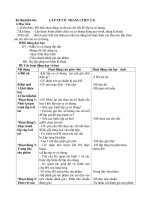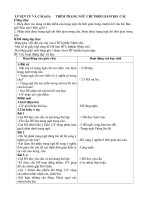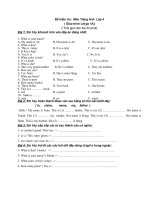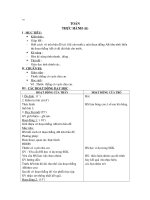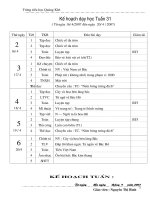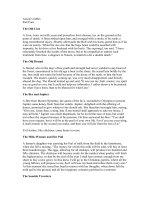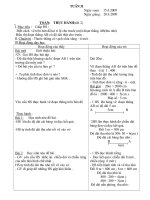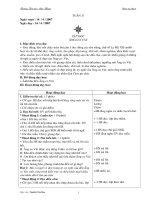English 4- week 31
Bạn đang xem bản rút gọn của tài liệu. Xem và tải ngay bản đầy đủ của tài liệu tại đây (110.24 KB, 9 trang )
<span class='text_page_counter'>(1)</span><div class='page_container' data-page=1>
Week 31 Period 119
Date of planning: 21/4/2017
<b>UNIT 18: WHAT’S YOUR PHONE NUMBER?</b>
<b>Lesson 1: 4-5-6</b>
<b> I. AIMS. </b>
By the end of this lesson, Ps will be able to listen and write specific information
about phone numbers.
1. Knowledge:
<b>Sentence patterns: review</b>
<b>Vocabulary: review</b>
<b>2. Skills: speaking, listening and reading</b>
3. Attitude: Ps know how to listen and write specific information about phone
numbers.
II. TEACHING METHODS:
- Work in pairs , individual, in groups ….
III. TEACHING AIDS:
<i>1. Teacher’s: student’s and teacher’s book, pictures, cassette.</i>
<i>2. Students’: books, notebooks, workbooks.</i>
<i>3. Class organization:</i>
Class Date of teaching Absent pupils
4A
4B
24/4/2017
24/4/2017
………
………
IV. PROCEDURE:
Teacher’s activities Pupils’ activities
Spend a few minutes revising the previous lesson.
Call a few pairs to the front of the class to ask and
answer the question What’s ….’s phone number?
Work in pairs.
<b>II. New lesson:(30’)</b>
<b> 3. Listen and tick. (9’)</b>
a. Pre-listening:
- T looks at the books and sets the table:
- Tell the class that they are going to listen to three
dialogues about phone nubers and tick the correct
pictures.
- Have ps look at the pictures to identify that each
picture shows one phone number. Ask them how
these phone nubers are said in English. Have them
point to each of the pictures and say aloud the phone
number in English.
b. While-listening:
- Playthe recording more than once, if necessary. Ask
ps to listen to the recording and tick the correct
pictures. Tell them to focus on the phone numbers.
Look at the pictures.
Listen to the dialogues.
Ps answer the T’s
questions.
</div>
<span class='text_page_counter'>(2)</span><div class='page_container' data-page=2>
- Get ps to swap their answers befor you check as a
class.
Key: 1b 2c 3a
. Post listening:
- Play the game: Lucky numbers.
<b>4. Look and write.( 9’)</b>
<b>a. Pre- writing:</b>
- Set the scence:
- Tell ps that they are going to write phone numbers.
- Have them look at the pictures to identify the phone
numbers. Ask them how these phone numbers are
said English.
b. While- writing:
- Give ps time to do the task independently. Remind
them to write the words for the numbers.
- Get them to swap their answers before checking as a
class.
<i><b>Key:</b></i>
<i> 2. It’s eight-five, seven, </i>
<i>oh-nine-nine.</i>
<i> 3. It’s oh-nine-one-two, </i>
<i>two-eight-three,eight-oh-four.</i>
<b>c. Post writing:</b>
- Ask Ps to play a game: Whisper
<b>5. Let’s sing.(7’)</b>
- Tell ps that they are going to sing the song What’s
your phone number? Teach the song, following the
procedure in Teaching the unit components in
introduction.
- Have them read each line of the lyrics aloud. Check
comprehension.
- Play the recording all the way through. Ask ps to do
choral and individual repetition of the song line by
line.
- When ps are familiar with the tune, ask a pair to the
front of the class. Each of them sings one line of the
song. Then the class sings the song together and claps
<b>hands. </b>
Listen and check.
Exchange
Play the game.
Look at the pictures.
Listen to the teacher.
Ps complete.
Ps do the task.
Swap their answers.
Play the game.
Listen to the teacher.
Ps work in groups of three.
Ps sing.
<b>III. Consolidation:(3’)</b>
? What’s the content of the lesson? T- Ps
<b>IV. Home-link: (2’)</b>
- Do exercises in the workbook. Learn by heart the
new words and structures.
</div>
<span class='text_page_counter'>(3)</span><div class='page_container' data-page=3>
* Comments:
………
………
……….
Week 31 Period 120
Date of planning: 21/4/2017
<b>UNIT 18: WHAT’S YOUR PHONE NUMBER?</b>
<b>Lesson 2: 1-2-3</b>
<b> I. AIMS. </b>
By the end of this lesson, Ps will be able to Use the words and phrases related to the
topics Phone numbers and Outdoor activities. Accept and decline an invitation, using
Would you like to….? I’d love to/ Sorry, I can’t.
1. Knowledge:
Sentence patterns: Would you like to….? I’d love to/ Sorry, I can’t.
Vocabulary: go for a walk, go for a picnic, go fishing, go skating
<b>2. Skills: speaking, listening and reading</b>
3. Attitude: Ps can accept and decline an invitation
II. TEACHING METHODS:
- Work in pairs , individual, in groups ….
III. TEACHING AIDS:
<i>1. Teacher’s: student’s and teacher’s book, pictures, cassette.</i>
<i>2. Students’: books, notebooks, workbooks.</i>
<i>3. Class organization:</i>
Class Date of teaching Absent pupils
4A
4B
24/4/2017
24/4/2017
………
………
IV. PROCEDURE:
Teacher’s activities Pupils’ activities
<b>I. Warm up:(5’)</b>
Ask some ps to go to the front of the class to sing the
song What’s your phone number? The rest of the
class sing along and clap hands.
Ps sing the song.
<b>II. New lesson:(30’)</b>
<b>1. Look, listen and repeat. (7’)</b>
- Tell ps that they are going to read a story in which
the characters accept and decline an invitation, using
Would you like to….? I’d love to./ Sorry, I can’t.
- Have them look at three pictures to understand how
the language is used. Ask them questions such as:
<i>Who are they? ? Where are they?What are they</i>
<i>saying?(In picture a, Peter is calling Mai from his</i>
Listen.
Look at the pictures
</div>
<span class='text_page_counter'>(4)</span><div class='page_container' data-page=4>
<i>home, asking May I speak to Mai, please? And Mai</i>
<i>replies Speaking. Who is it? . Then Peter asks Would</i>
<i>you like to go for a picnic? And Mai answer Yes, I’d</i>
<i>love to.) Check understanding.</i>
- Play the recording a few times for ps to listen and
repeat. Do choral and individually repetition, pointing
to the characters speaking.
<b>- Play the recording again for Ps to listen and repeat.</b>
<b>2. Point and say.(11’)</b>
<b>- Have them look at three pictures to understand the</b>
<i>collocations: go for a walk, go for a picnic, gofishing</i>
<i>and go skating</i>
+ Checking: Rub out and remember.
b. Model sentences:
<i>A: Would you like to go for a picnic?</i>
<i>B: I’d love to.( Sorry, I can’t)</i>
- Concept check: intonation, using
c. Practice:
- Tell ps that they are going to practise making and
accepting/ declining an invitation, using Would you
like to….? I’d love to./ Sorry, I can’t.
<b>- Have them look at three pictures to understand the</b>
collocations go for a walk, go for a picnic, gofishing
<i>and go skating. Point to picture a and have them</i>
repeat the words under it. Do choral and individual
repetition. Then tell the class to practise making an
invitation and accepting or declining it in pairs.
- Repeat the same procedure with the rest of the
pictures. Do choral and individual repetition and then
practise in pairs.
- Call a few pairs to act out the dialogue in front of
the class. Check as a class or correct pronounciation,
if necessary.
d. Production:
- Role play.
<b>3. Let’s talk. (7’)</b>
- Tell Ps that they are going to revise what they have
learnt in L1 and 2. Remind them of the questions May
I speak to….? Would you like to….? What’s your
phone number? And how to respond to these
questions.
- Ask them to work in pairs: one ps asks the questions
and the other gives the answers. Remind them to use
Listen and repeat in chorus
and individual.
Look , listen and repeat in
choral then individual.
Listen and repeat.
T – W – C
H – H
O – P -> C – P
Ps practise asking and
answering.
Look at the bubbles and
answer the questions.
Ps work in pairs.
Pairs do the task.
</div>
<span class='text_page_counter'>(5)</span><div class='page_container' data-page=5>
facts about themselves. Go around offering help.
Correct pronunciation, if necessary.
- Call a few pairs to act out their dialogue in front of
<b>the class. </b>
Ps act out.
<b>III. Consolidation:(3’)</b>
? What’s the content of the lesson? T- Ps
<b>IV. Home-link: (2’)</b>
- Do exercises in the workbook. Learn by heart the
new words and structures.
Individually
* Comments:
………
………
……….
Week 31 Period 121
Date of planning: 21/4/2017
<b>UNIT 18: WHAT’S YOUR PHONE NUMBER?</b>
<b>Lesson 2: 4-5-6</b>
<b>I. AIMS. </b>
By the end of this lesson, Ps will be able to listen and write specific information
about Phone numbers and Outdoor activities, Accept and decline an invitation
1. Knowledge:
Sentence patterns: review
Vocabulary: review
<b>2. Skills: speaking, listening and reading</b>
3. Attitude: Ps know how to accept and decline an invitation
II. TEACHING METHODS:
- Work in pairs , individual, in groups ….
III. TEACHING AIDS:
<i>1. Teacher’s: student’s and teacher’s book, pictures, cassette.</i>
<i>2. Students’: books, notebooks, workbooks.</i>
<i>3. Class organization:</i>
Class Date of teaching Absent pupils
4A
4B
26/4/2017
28/4/2017
………
………
IV. PROCEDURE:
Teacher’s activities Pupils’ activities
<b>I. Warm up:(5’)</b>
Spend a few minutes revising the previous lesson.
Invite some pairs of ps to go to the front of the class,
asking and answering the questions May I speak
to…..? Would you like to…?
</div>
<span class='text_page_counter'>(6)</span><div class='page_container' data-page=6>
<b>II. New lesson:(30’)</b>
<b> 4. Listen and circle.(9’)</b>
a. Pre-listening:
- T looks at the books and sets the scence:
<i><b> How many sentences are there?</b></i>
- Tell the class that they are going to listen to four
dialogues and circle the correct words or phone
numbers to complete the sentences.
- Give ps a few seconds to read the incomplete
sentences in silence and guess the answers to fill the
gaps.
b. While-listening:
- Play the recording more than once, if necessary, for
ps to listen and circle the answers.
- Get them to swap their answers before you check as
a class. Monitor the activity and offer help, if
necessary.
Key: 1a 2b 3a 4b
c. Post listening:
- Play the game: Musical box
<b>5. Look and write.(9’)</b>
<b>a. Pre- writing:</b>
- Set the scene:
- Tell ps that they are going to write questions, using
the given answers and the picture cues.
- Have them read the answers and the incomplete
questions. Then ask them to look at the picture above
each question and guess the words to complete the
questions.
b. While- writing:
- Set a time limit for ps to do the task independently.
Go around offering help, if necessary.
- Get them to swap their answers before checking as a
class.
Key:
<i>1. to go swimming 2. Would you like to go for a</i>
<i>picnic</i>
<i>3. your phone number 4. May I speak to</i>
c. Post writing:
- Play the game: Lucky number.
<b>6. Let’s play.(7’)</b>
- Tell ps that they are going to play the game Find the
phone numbers.
Answer T’s questions
Look at pictures and
answer the questions.
Listen and circle the
pictures. Work individual
Listen again to check.
Work in pairs.
Play the game.
Look at the sentences.
Answer T’s questions.
Read questions
Write the answers.
Read aloud the completed
text.
Play the game into 2
teams.
Listen.
</div>
<span class='text_page_counter'>(7)</span><div class='page_container' data-page=7>
- Prepare 30 small pieces of paper. On each of them,
write a number from 0 to 9 so that there are in total
three instances of each number. Put the pieces of
paper in a box. Ask two pairs of ps to come out and
stand next to the box. Say a phone number. The pair
that is quicker to find the correct numbers from the
box and put them in the correct order gets a point and
continute to play the game with another pair. The pair
that gets the most points at the end of the game is the
<b>winner. </b>
<b>III. Consolidation:(3’)</b>
? What’s the content of the lesson? T- Ps
<b>IV. Home-link: (2’)</b>
- Do exercises in the workbook. Learn by heart the
new words and structures.
Individually
* Comments:
………
………
……….
Week 31 Period 122
Date of planning: 21/4/2017
<b>UNIT 18: WHAT’S YOUR PHONE NUMBER?</b>
<b>Lesson 3: 1-2-3</b>
<b>I. AIMS. </b>
By the end of this lesson, Ps will be able to Pronounce two- syllable words with the
stress on the second syllable: re’peat, en’joy, in’vite and com’plete.
1. Knowledge:
Sentence patterns: revision
Vocabulary: revision
<b>2. Skills: speaking, listening and reading</b>
3. Attitude: Ps know how to pronounce two- syllable words with the stress on the
second syllable
II. TEACHING METHODS:
- Work in pairs , individual, in groups ….
III. TEACHING AIDS:
<i>1. Teacher’s: student’s and teacher’s book, pictures, cassette.</i>
<i>2. Students’: books, notebooks, workbooks.</i>
<i>3. Class organization:</i>
Class Date of teaching Absent pupils
4A
4B
26/4/2017
28/4/2017
</div>
<span class='text_page_counter'>(8)</span><div class='page_container' data-page=8>
IV. PROCEDURE:
Teacher’s activities Pupils’ activities
<b>I. Warm up:(5’)</b>
Spend a few minutes revising the previous lesson.
Have ps play the game Say the phone numbers again.
Ps answer the questions.
<b>II. New lesson:(30’)</b>
<b> 1. Listen and repeat. (9’)</b>
- Tell ps that they are going to practise pronouncing
<i>the following words: re’peat, en’joy, in’vite and</i>
<i>com’plete.</i>
<i>- First, put the words re’peat, en’joy, in’vite and</i>
<i>com’plete on the board, with the stress marks. Play</i>
the recording and ask ps to repeat the words a few
times. Then put the four sentences on the board. Play
the recording more than once, if necessary, and let ps
say the sentences, paying attention to the target words
and stress.
- Do the choral and individual repetition of the words
and sentences until ps feel confident.
- Get some ps to say the sentences, while the rest of
the class claps at the stressed syllables of the target
words. Correct the pronounciation, if necessary.
<b>2. Listen and circle. Then say the sentences aloud.</b>
<b>(9’)</b>
- Tell ps that they are going to listen to the recording
and circle the correct answers.
- Give them a few second to read the sentences in
silence and guess the words to fill the gaps.
- Have ps listen to the recording and circle the
answers. Go around offering help, if necessary.
- Have them swap their answers before checking as a
class. Then ask them to read aloud the answers.
<i>Key: 1a 2b 3 b 4a</i>
<b>3. Let’s chant.(7)</b>
- Tell ps that they are going to say the chant I’d like
to invite you to my party. Follow the procedure in
Teaching the unit components in introduction.
- Have them read the chant and check comprehension.
- Play the recording a few times for ps to do choral
and individual repetition. Show them how to chant
and do actions. Call two groups to give a
demonstration.
- Get groups to sit opposite of each other and practise
Listen to the teacher.
Listen and repeat then
write.
Listen and repeat.
Ps perform.
Listen to the teacher.
Read the sentences.
Listen and circle.
Swap their answers.
Play the game.
Listen the the teacher.
Read the chant.
Listen and sing.
</div>
<span class='text_page_counter'>(9)</span><div class='page_container' data-page=9>
chanting and doing actions. Go around offering help,
if necessary.
- Call two groups to the front of the class to chant and
do actions. The rest of the class claps along to the
<b>rhythm. </b>
doing actions in groups.
Sing in groups.
<b>III. Consolidation:(3’)</b>
? What’s the content of the lesson? T- Ps
<b>IV. Home-link: (2’)</b>
- Do exercises in the workbook. Learn by heart the
new words and structures.
Individually
* Comments:
………
………
……….
</div>
<!--links-->
